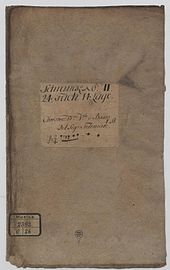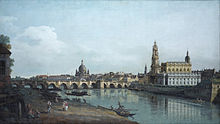Cabinet No: II

The so-called Schranck No: II (also cabinet II ) was a music cabinet in the Catholic Court Church in Dresden , in which the collection of music for instrumental works compiled by the court concert master Johann Georg Pisendel in the 18th century was stored. The special importance of this collection, which includes around 1800 pieces of music, lies in its unique structure, which reflects the entire instrumental repertoire of the Dresden court orchestra during the time of August the Strong . The collection is now in the Saxon State Library (SLUB). The cabinet itself has not been preserved.
collection

In European music history, the time of the Saxon-Polish Union (1697–1763) is considered a heyday of baroque opera, vocal church music and brilliant instrumental works. At the center of musical life was the Saxon court orchestra, which became world-famous under the conductor Johann Adolph Hasse , who had been in office since 1733, and his concertmaster, Johann Georg Pisendel, who had been in office since 1712 .
Than by Prussian artillery fire as a result of at the siege of Dresden 1760 Seven Years War burned the courtly music archive, located in the Prince's Palace was located, remained only the music remains, which were stored elsewhere, were still in use or in places other than copies exist (such as for example the Jacobi collection in Grimma).
The musical material stored in other places included the numerous instrumental music manuscripts with performance-practical drawings by Pisendel and the scores he made himself, some of which go back to his trip to Italy in 1716/1717. After his death in 1755, the collection was initially sold to Crown Princess Maria Josepha of Saxony and sorted alphabetically for about ten years, labeled in envelopes and stored in "Schranck No: II" in the Dresden Court Church, after which it was initially forgotten due to the changed musical taste.
The newly appointed Dresden court conductor Julius Rietz rediscovered the collection in this so-called cabinet No: II in the gallery of the Dresden court church in 1860 . Moritz Fürstenau , custodian of the Royal Private Musical Collection and flautist of the court orchestra, then gave them new signatures and incorporated them into the holdings of the Royal Private Musical Collection.
With their transfer to the Royal Public Library (1896), the manuscripts were transferred to a predecessor institution of today's Saxon State Library. They were archived in the music department, which subsequently developed into one of the most important historical music collections in Germany through the takeover of the no longer used sheet music from the court church and court opera, and received the three-part music source signatures introduced from 1926 and still valid today.
The sheet music fund includes more than 1750 pieces of music, which contain works by almost 200 German and European composers, which were housed in 38 compartments of the cabinet. In addition to Pisendel compositions, these include well-known names such as Antonio Vivaldi , Tomaso Albinoni , Georg Philipp Telemann , Georg Friedrich Händel , Johann Joachim Quantz and the Graun brothers . But also lesser known composers such as Johann Ignaz Beyer , who worked in the Viennese environment, and Domenico Elmi (1676–1760), who is proven in Venice, are represented.
Signatures

The original signatures are noted on the title labels of the original covers, for the most part still preserved; they each consist of a compartment number and a layer number. Fürstenau replaced the original signatures with consecutive numbering, which extends from Mus.c.Cx 1 to 1576. This made it possible to reconstruct the exact location (subject and location) within the Schranck-No: -II order even for those manuscripts that no longer have a title label. Today the manuscripts have the usual three-part SLUB signatures, which consist of a four-digit number for the composer (e.g. "2392" for Telemann), a letter for the genre (e.g. "O" for concerts) and one put together consecutive numbering (e.g. "Mus.2392-O-2").
Recordings (selection)
- Oboe concerts from Dresden - instrumental music from the Pisendel collection. Works by Pisendel, Fasch , Valentini, Anonymus. Accent, DDD, 2007, Löffler, Bosch, Batzdorfer Hofkapelle .
- Dresden Baroque Music - Sonatas from the Pisendel Collection. Accent, DDD, 2008, Batzdorfer Hofkapelle.
- Violin concerts from Dresden. Raumklang (Harmonia Mundi), DDD, 2011. Johannes Pramsohler, International Baroque Players.
- 1717. Memories of a Journey to Italy. Pisendel, Vivaldi, Montanari, Fanfani, Valentini and Albinoni. Scaramuccia Ensemble . ( Snakewood Editions , 2018). Music collected or composed by Pisendel during his journey to Italy 1716-1717
literature
- Katrin Bemmann, Steffen Voss : Instrumental music by the Dresden court orchestra, newly accessible on the Internet , in: Forum Musikbibliothek 31 (2010/1), pp. 17-26.
- Gerhard Poppe, Katrin Bemmann, Wolfgang Eckhardt, Sylvie Reinelt, Steffen Voss: Schranck No: II. The preserved instrumental music repertoire of the Dresden court orchestra from the first two thirds of the 18th century. Forum Mitteldeutsche Barockmusik om156 / Volume 2, ortus musikverlag Beeskow and Berlin 2012. ISBN 978-3-937788-29-6 .
Web links
- Website of the Cabinet II project
- Caroline Vongries: Georg Philipp Telemann incognito in his hometown. In: Volksstimme , September 3, 2012 (on the performance of a composition attributed to Telemann from Cabinet II)
- Katrin Bemmann, Steffen Voss: A sheet music cabinet is going online. ( Memento from March 4, 2016 in the Internet Archive ) In: BIS - The magazine of the libraries in Saxony , Vol. 3, No. 1, March 2010, pp. 14–16 (PDF; 4.0 MB)
- The “Closet II” or the legacy of Concert Master Johann Georg Pisendel. Snakewood Editions, January 5, 2019 (English)
